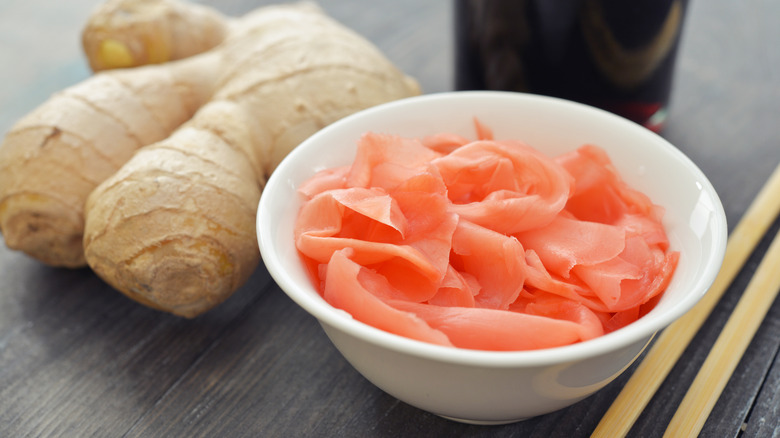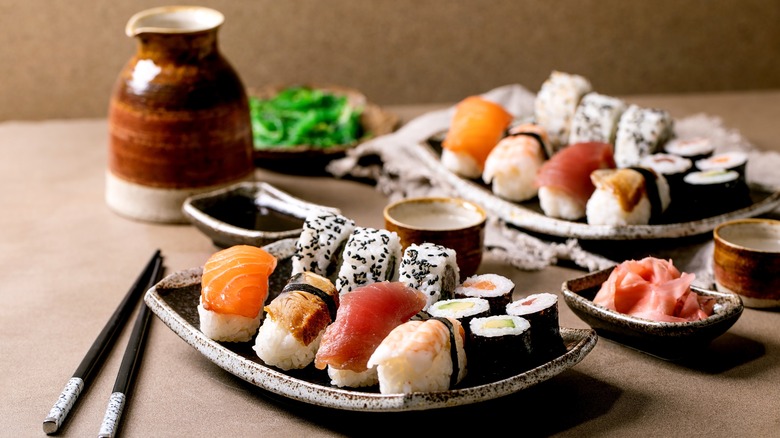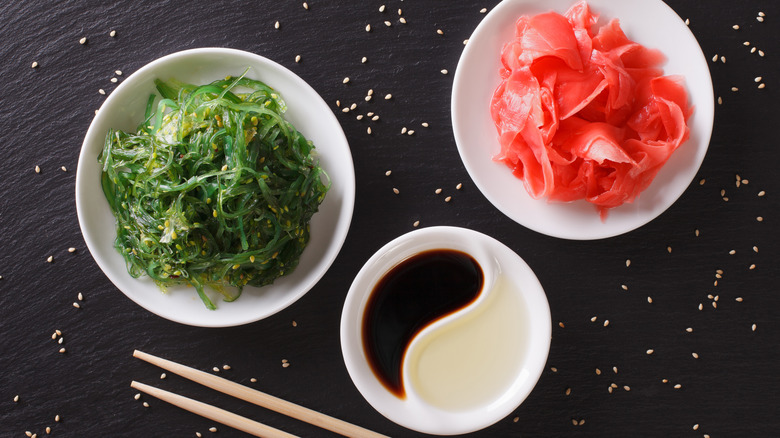The Reason Sushi Ginger Is Pink
If you've ever eaten sushi, chances are you have encountered those paper-thin slices of ginger nestled in a corner of the plate, usually featured alongside a small mound of green wasabi. Also known as gari, it's a prominent part of the etiquette when eating sushi properly since it's designed to clear your palate between eating different types of fish. As an example, if you like to switch back and forth eating your maki and nigiri selections, you might want to consume some ginger in between the bites. Some also believe it enhances the taste of the Japanese dish.
Gari is quite striking in appearance but also may raise some questions. For example, why is the pickled ginger on your sushi plate a pink hue when most ginger you see at the grocery store is often pale yellow in color? While it's easy to assume that it was dyed for taste or aesthetic reasons (some jarred versions are in fact dyed with beet juice), the real reason for the bright color of fresh sushi ginger stems from the process of pickling and the part of the ginger root that was used to make it.
Origins of pink ginger and how to make it at home
Gari uses young ginger as its base. It's typically harvested in late spring or early summer before it matures and is distinctive for having a translucent skin, juicier flesh, milder flavor, and trademark pink roots. The pink hue develops further in the pickling process — this is when the young ginger root is sliced and added to a mixture of rice vinegar, salt, and sugar and then left to soak. Over time, the liquid brings out the pigment stored in the root.
If you want to try making it yourself, the process is quite simple. If there is an Asian market in your town, you might be able to find fresh young ginger during the early summer season, often packaged as "new ginger." Because its exterior is so thin, you can peel the skin of young ginger with a spoon. Once the skin is removed, slice the ginger paper-thin with a sharp knife or mandolin. Next, blanch the slices in boiling water and lay on paper towels to dry and cool before squeezing out the excess water. Then, place the ginger slices in a heat-proof and nonreactive container such as a glass jar.
Separately, you'll want to mix rice wine vinegar, sugar, and salt in a pot and bring it to a boil. After everything is dissolved, let the mixture cool slightly, then pour into the jar filled with ginger slices. Store in the refrigerator until you're ready to use it.
Using pickled ginger for more than sushi
Aside from using pickled ginger as just a palate cleanser when eating sushi, it can lend its zesty flavor to a variety of other recipes. It can be used as a topping for poke rice bowls and soba noodle salads to give the dishes a sweet and gingery note. It can also be used in a stir-fry when finely sliced — a great example is pairing it with sliced lean beef and scallions. Pickled ginger can also be used as an ingredient for a refreshing vinaigrette to top an Asian salad. To make the dressing, you simply mince the ginger and mix with soy sauce, rice wine vinegar, and sesame oil.
It also should be noted that if your pickled ginger did not naturally turn a pink hue when making it at home, it doesn't mean there's anything wrong with it. Not all ginger varieties react the same way during the pickling process, and even though it looks different, it will still be delicious.



